

Salmon chowder garnished with bacon and chives. Photo courtesy Whole Foods Market.
April 2010
Last Updated October 2013
|
 |
Types Of Soup: C
Page 3: Do You Know A Chowder From A Consommé?
This is Page 3 of a six-page glossary of types of soup. On this page, find well-known soups like chowder, consommé and cream coup as well as cock-a-leekie. There are thousands of types of soup in the world’s cuisines. This glossary focuses on soups found in the U.S. Click on the black links below to visit other pages. See all of our delicious food glossaries.
CHEESE SOUP
Cheese serves as a principle ingredient in many soups. Generally a hearty cheese such as Cheddar, Jack, pepper cheese or Swiss is combined with apples, beer, bacon, broccoli, cauliflower, chicken, ham, sausage, tomato, tuna or other ingredients. Broccoli and cheddar is a popular American soup. An elegant French soup combines blue cheese with celeriac and pear.
CHICKEN SOUP
There are many types of chicken soup, from the clear (aspic, bouillon, broth, consommé and that all-American favorite, chicken noodle) to the thick (cream of chicken soup and a richer and more elegant version, velouté). And we can’t forget “Jewish penicillin,” chicken soup with matzoh balls. Then there are the international chicken soups, from Greek avgolemono soup to Italian Stracciatella and Chinese wonton soup. Chicken can be an ingredient in any type of soup—except vegetarian soup! |
|
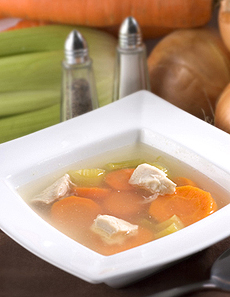 Chicken soup in a clear broth. Photo courtesy GrandmasChickenSoup.com. Chicken soup in a clear broth. Photo courtesy GrandmasChickenSoup.com.
|
CHOWDER
To many Americans, a chowder is a soup with fish or seafood as the main ingredient, like the salmon chowder in the photo at the top of the page. However, non-fish chowders such as corn chowder and chicken chowder are also made, such as the corn and potato chowder in the photo at right. Potatoes and other vegetables are typically added and the soup is enriched with salt pork fatback and thickened with flour or crushed soup crackers—two ingredients that define a chowder. The name derives from the French word for the pot in which such a soup was cooked, chaudière, from the Latin caldaria. The word came to New England via Newfoundland, where Breton fishermen tossed some of the day’s catch into a large pot to make soup. That soup was originally thickened with crushed ship’s biscuits; now flour is used.
|
|
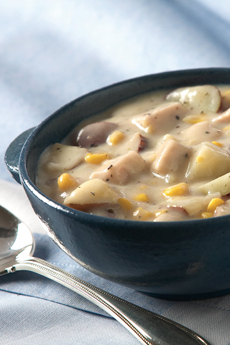
Corn and potato chowder. Photo courtesy McCormick.
|
- New England clam chowder is made with a milk base; Manhattan clam chowder uses stewed or canned tomatoes instead of milk.
- The difference between a chowder and a bisque is that a bisque is a more elegant recipe, puréed until smooth, and often contains sherry.
CIOPPINO
While many people think cioppino (pronounced cho-PEA-no) is an Italian dish, this fish stew originated in the North Beach section of San Francisco the late 1800s. Italian-American fishermen would make this hearty dish, based on regional Italian recipes for fish soups and stews, on their boats, using the catch of the day. The San Francisco Bay waters yielded clams, Dungeness crabs, clams, mussels, scallops, shrimp, squid and various fish, which were combined with fresh tomatoes in a wine sauce. The dish caught on at local restaurants, where it was often served over long-cut pasta with a side of toasted sourdough. It has become an American version of bouillabaisse.
|
|
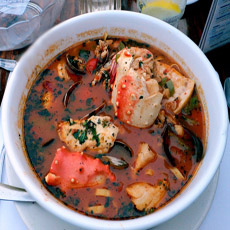
Cioppino, a fish stew. Photo by Kelly Sue DeConnick | Wikimedia.
|
COCK-A-LEEKIE SOUP
This exotic-sounding soup from Scotland is simply a hot chicken soup made with leeks instead of onions. The first printed recipe, dating to 1598, included prunes. While prunes went out of style in the 19th century, today some cooks garnish the soup with a julienne of prunes.
COLD SOUPS
Cold soups are those served at room temperature or chilled. While one would think that this is the preferred soup of those living in warm countries, such as the gazpacho of southern Spain, they are also made in cold climes from Russia (borscht) and Scandinavia (fruit soup) to the tarator (cucumber soup) of Bulgaria and the sour cherry soup of Hungary.
|
|
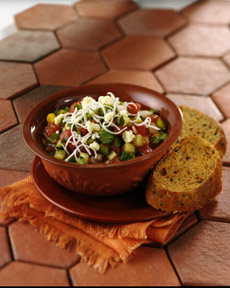
Gazpacho, a cold vegetable soup. Photo courtesy Wisconsin Milk Marketing Board.
|
CONSOMMÉ
Consommé is a refined broth. The term in French dates back to the 16th century. Meat or fish broth is clarified; this is usually done with egg whites. Egg whites, tempered with some of the broth, are added to the soup pot. As the whites solidify in the hot soup, they gather up all the floating bits of meat, vegetable, etc. The “raft” of egg whites that results is removed, leaving a clear soup. This is a much more efficient process than straining the soup several times—and the raft, essentially poached egg whites, can be eaten by the cook. Gelatin filtration is much easier for home cooks, but results in a gelatin-free broth. The gelatin that remains after egg white filtration has a much richer mouthfeel. |
|
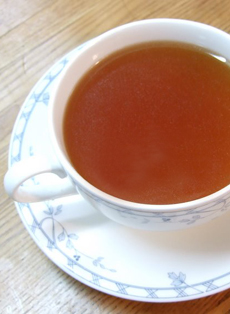
Consomme. Photo by Kui Doraku | Wikimedia.
|
Food History: Many of our soups date back to the Middle Ages. A dessert consommé, boiled solely with tendons and cartilage and without salt, was sweetened, flavored with fruits and served as dessert. These sweetened consommés evolved into today’s gelatin desserts, such as JELL-O.
COURT BOUILLON
In French, court bouillon means “short bouillon,” a light stock used for poaching fish or shellfish. It is made from water and the usual mixture of vegetables (carrots, celery and onions) plus herbs—basil, bay leaf, clove, parsley, thyme—with the optional addition of white wine or vinegar (for freshwater fish). According to FoodTimeline.org, the term has been used in English texts since the early eighteenth century, but as fish and shellfish were expensive, it was the province of the wealthy.
CUCUMBER SOUP
Cucumber soup can be served hot or cold, with a chicken or vegetable stock base, a cream base or Mediterranean-style, with a yogurt base. One Mediterranean version is tarator, popular in the cuisines of Albania, Armenia, Bulgaria, Cyprus, Iran (Persia), Macedonia, Serbia and Turkey. It is made of yogurt, cucumbers, garlic, walnuts, dill and olive oil. Local variations may add vinegar and/or bread, omit nuts and/or dill. The soup is very refreshing, like Greek tzatziki and Indian raita—thicker versions that serve as dips and spreads (see recipes).
|
|
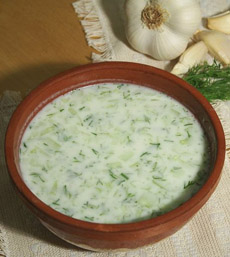
Tarator, a Bulgarian cucumber soup. Photo by L. Konact | Wikimedia.
|
CREAM SOUP
Cream soup is based on a classic French cream sauce (béchamel*) and is highly nutritious because of the cream protein plus the meat and vegetables (or fish and/or grains). The creamiest of all soups is a velouté. It is highly nutritious because of the addition of vegetables, meat, fish or grains. Almost any vegetable can be used in a cream soup (broccoli, carrot, cauliflower, celery, tomato, pea and potato, to offer a few); any seafood (crab, lobster, shrimp, scallop, uni) and milder meats, such as chicken. Combining vegetables and meats is popular. A cream soup can be seasoned largely with spices; for example, curry soup has a consommé and cream base with curry powder (often apple and onion are added for texture and to layer the flavors). Cream soups can be thickened for heartier winter fare.
|
|
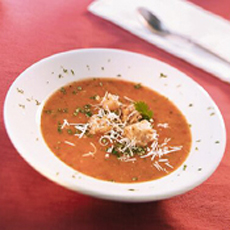
Cream of roasted tomato soup, garnished with shaved cheese and croutons. Photo courtesy Wisconsin Milk Marketing Board.
|
*Béchamel sauce, named after Louis de Béchameil, marquis de Nointel (1630–1703), is made by stirring 3 tablespoons of flour into 2 tablespoons of melted butter to create a roux; then, when the roux has stopped bubbling, adding two cups of boiled milk plus 1/4 teaspoon salt to the roux and whisking until the sauce forms. Béchamel is one of the five mother sauces of French cuisine.
Continue To Page 4: Soups Beginning With D to N
Go To The Article Index Above
Lifestyle Direct, Inc. All rights reserved. Images are the copyright of their individual owners.

|











